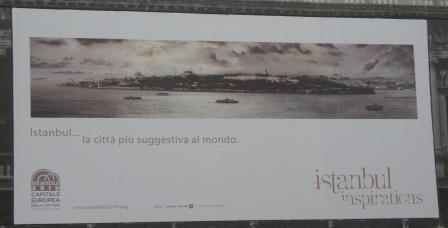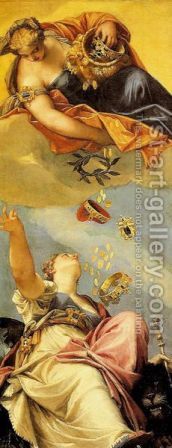Power-walking to the Piazza San Marco two days ago, what should I see but a new mega-piece of publicity covering the facade of the Biblioteca Marciana. And it’s not for Swatch or whoever else has recently benefited from what must be one of the more valuable pieces of billboard space in a major town.
Nope: It’s advertising Istanbul.
In an exceptionally elegant and simple design — with the added allure of a black-and-white photograph that makes the former capital of the Byzantine and Ottoman Empires look like Rita Hayworth swathed in Blackglama mink — the world is being advised not only that Istanbul in 2010 is going to be a European Capital of Culture, but that it is “the most evocative city in the world.” The world. It says so right there.
Not a bad choice of words, considering that Venice seems to have a lock on the phrase “most beautiful city,” though the echo is a little unfortunate. And defining itself as “European” is pretty cool, considering that much of Europe is doing everything it can to make sure only it knows the combination to the lock into the EU. I suppose that the fact that part of Istanbul sits on the European side of the Bosporus could technically make this term admissible.
What struck me first as I went striding past was a bracing blast of irony. (I seem to be unusually susceptible to these, like some people are to drafts or mold.) Between 1463 and 1718 Venice was involved in eight major wars with the Ottoman Empire, and a war isn’t some little let’s-agree-to-disagree. Countless Venetians died in all sorts of ways, especially their commanders — Marcantonio Bragadin was flayed alive, Paolo Erizzo was sawn in half — enduring epic sieges, making phenomenal sacrifices, and even achieving one of the great naval victories of history, October 7, 1571, at Lepanto.
And now we have its capital, the Sublime Porte, the epicenter of enmity, looking all sorts of gorgeous and up in the Piazza San Marco, no less.
But on the other hand, what about the Fontego dei Turchi up on the Grand Canal? For centuries there was a thriving Turkish business community right here, which was allowed to have its own headquarters, just like the Germans, Persians, Arabs and many others. This type of establishment was known as a fontego (in Italian, fondaco, from the Arabian fonduk, meaning “inn”) and these establishments usually contained storerooms, strong-rooms for cash, meeting rooms, even bedrooms. (In the case of the Turks, their fontego also contained a hammam and a mosque.)
For a foreign merchant doing business in Venice, having a home base was extremely helpful. It was no less helpful to the Venetian government, considering that keeping ethnic groups corralled simplified surveillance. Simply put, scimitars may have flashed elsewhere, but here Turkish traders were just another part of the immense and complicated commercial reality that sustained Venice’s seemingly effortless glamor.
So that’s what struck me second: That in fact there isn’t any irony at work here at all. Venice had constructed so many trade connections, treaties, and other means of coexistence with the Muslim world — Egyptian Mamluks, Ottoman Turks, and so on — that it’s almost as if the wars occurred on another plane from the daily/yearly business of business. Your Venetian, whether patrician merchant or grimy artisan, was never in doubt as to the need to cultivate and maintain clients; whenever the Pope occasionally placed bans on trade with Them over There, Venice just kept going, trading as usual except by way of Cyprus and Crete.
In fact, Ottoman markets were crucial to Venice’s prosperity, being insatiable customers for Venetian luxury goods: heavy fabrics of silk (especially velvet) and wool, glass, books, and china. Venetians also exported work in gold, especially filigree, which was famous throughout Europe. As one historian puts it, “Without trade with the Muslim world, Venice would not have existed.”
Yes, this is actually how my brain works as I’m cantering around Venice trying to get assorted things done: buying fish, picking up dry cleaning, replacing the battery in my watch, collecting shoes from the man who calls himself a cobbler but who evidently isn’t able or interested in doing anything other than replacing heels. Try to get him to stitch a torn strap on a handbag and he goes all helpless on you, as if the machinery (one hand, one needle, one piece of heavy string) hadn’t been invented.

So while I’m involved in the daily drudgery, dealing with all those little tasks that breed in dark corners at night and produce litters of new little tasks every day, I’m also meandering around mazes of history. I really like living in a city that gives you so many centuries and points of view all knotted up together.
And from what I keep noticing about Venice’s history, I think they really hated having to get involved in all those wars (and not just with the Ottomans, either). Put aside the possibility of death or dismemberment; wars with anybody are so bad for business, so distracting, so disrupting. How much more tempting is the clinking of coins, so warm, so musical. Except, of course, that the wars were intended to make more clinkage possible, otherwise there wouldn’t have been much point in bothering.
So here’s my conclusion: What better place than Venice to publicize Istanbul? That huge billboard practically amounts to the Return of the Native.


5 Comments
I love this kind of thoughts and reflections.
Also the idea of making Istanbul the European Capital of Culture for one year is perfectly ok for me. Because its history since Roman and Byzantine times just can’t be separated from European history. And in the fields of art and culture and religion the Byzantine culture seems to be the base for the East European branch of christianity.
I also like this billboard. The wide-angle photo of Istanbul so surrounded by water and ships is made to make it look like Venice’s twin city 🙂
Also the city where I live – Vienna – had its own special “love and hate” relationship with the Ottomans. Heck, those guys arrived directly at our city gate in order to conquer us 😉 But nonetheless there was a fascination and fashion for Turkish stuff – this is how the Viennese learnt to drink coffee and eat crescent-shaped “Kipferl”, and even Mozart composed music named “alla turca”. It was stylish.
In contrary to this, the dumb xenophobia which rules in Austria nowadays is a shame. BTW, one openly xenophobe party uses exactly this campaign slogan: “Vienna must not become Istanbul!”
Very interesting observations. I too have always heard that kipferl and croissants were celebratory inventions following Turkish defeats. Unfortunately, a little investigation reveals that these are culinary legends; people were making crescent-shaped pastries before the events in question. That doesn’t make them any less delicious or bad for you, just that one needs to regard them with a different story line. Or not. Some stories need to stay the way they ought to have been!
This is interesting: I actually haven’t heard this exact version yet – that Kipferl were an invention following Turkish defeats. 🙂
My idea is rather, that the two things – a) wars and b) a certain fashion and interest in Turkish stuff – coexisted. But I don’t know it precisely.
Maybe it’s just natural that people were a bit fascinated with foreign, colorful countries and cultures. Even if they thought that all non-Christians will end up in hell 😉
Also when looking at paintings I see that foreigners were usually depicted in an interesting and imaginative way.
Anyway, the sober but sweet sound of money surely was the main motivation for merchants and artisans in Venice and elsewhere. And there’s nothing wrong about it.
the photographer was:
http://www.rainerstratmann.com/
Your nice blog is obviously worth a read if anyone results in it. Im lucky i did so because now Ive got a full new view of this particular. I didnt realise that this issue was so important and therefore universal. You definitely put it in perspective for all of us, thanks for the fantatic details.